International Space Station (ISS)
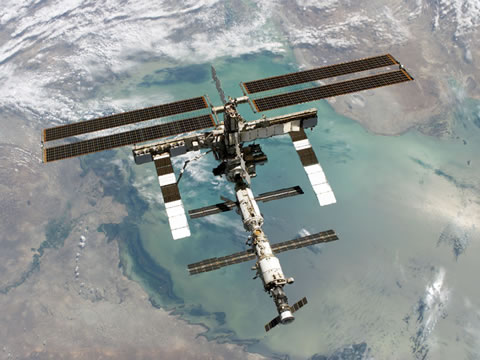 |
The ISS photographed from shuttle Discovery in 2006
|
 |
ISS configuration as of December 2007
|
| ISS statistics |
|---|
| Current mass | 245,735 kg (540,617 lb) | | Final mass | 471,736 kg (1,040,000 lb) | | Length (along truss) | 58.2 m (191 ft) | | Width (Destiny to Zvezda) | 44.5 m (146 ft) | | Span of solar arrays | 73.15 m (240 ft) | | Habitable volume | 424.75 m3 (15,000 ft3) | | Solar array area | 2,500 m2 |
|
 |
Planned 2012 configuration of ISS
|
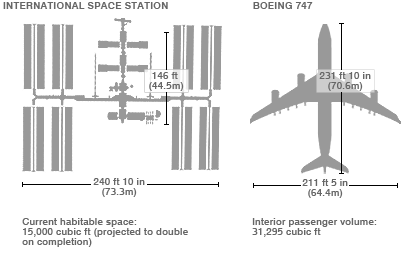 |
Size comparison of the ISS and a Boeing 747.
|
The largest space station ever built, the largest structure ever assembled in space, and one of the most complex international scientific projects in history. When complete, in 2010, the ISS will be over four times larger than Mir and longer than an American football field (including the end-zones), have a pressurized living and working space equivalent to the volume of a 747 jumbo-jet, and be able to accommodate up to seven astronauts. The solar panels, spanning more than half an acre, will supply 60 times more electrical power than that available to Mir.
The 400-km-high orbit of ISS, inclined at 51.6°, allows the station to be reached by the launch vehicles of all the international partners for delivery of crews, components, and supplies. The orbit also enables observations to be made of 85% of the globe and over-flight of 95% of Earth's population.
When complete, ISS will have a Habitation Module for its crew as well as six scientific laboratories for research – an American laboratory, the ESA (European Space Agency) Columbus Laboratory, a Japanese experiment module, and three Russian research modules. It is expected to remain in operation until 2016.
History
In 1984 President Ronald Reagan committed the United States to developing a permanently-occupied space station and, along with NASA, invited other countries to join the project. Within little more than a year, nine of ESA’s 13 member countries had signed on, as had Canada and Japan.
In 1991 President George Bush (senior) and Soviet Premier Mikhail Gorbachev agreed to jointSpace Shuttle-Mir missions that would lay the groundwork for cooperative space station efforts. From 1993 to the present, NASA has had to contend with numerous cost overruns and tight federal space budgets, plus the tragic loss in 2003 of the Space Shuttle Columbia that have eroded the station’s capabilities and delayed its completion. Nevertheless, by streamlining the program, simplifying the station’s design, and negotiating barter and cost-sharing agreements with other nations, NASA and its international partners have made the ISS a reality.
On-orbit assembly of the station began on November 20, 1998, with the launch of the Russian-built Zarya control module, and is due for completion sometime after 2010.
International contributions
Although the United States, through NASA, leads the ISS project, 15 other countries are involved in building and operating various parts of the station – Russia, Canada, Japan, Brazil, and 11 member nations of ESA (Belgium, Denmark, France, Germany, Italy, The Netherlands, Norway, Spain, Sweden, Switzerland, and the United Kingdom.
Contributions include:
United States- truss structures that provide the ISS framework
- four pairs of large solar arrays
- three nodes with ports for spacecraft and for passage to other ISS elements
- airlock that accommodates American and Russian spacesuits
- the American laboratory (Destiny)
- habitation and centrifuge accommodation modules
- power, communications and data services
- thermal control, environmental control and life support health
Russia- two research modules
- service module with its own life support and habitation systems
- science power platform that supplies about 20 kilowatts of electrical power
- logistics transport using Progress vehicles and Soyuz spacecraft crew rotation
ESA- Columbus Orbital Facility (pressurized laboratory and external payload accommodations)
- logistics transport vehicles to be launched by the Ariane V
Canada- Mobile Servicing System (17-m-long robotic arm and with a smaller manipulator attachment
- a Mobile Remote Servicer Base to allow the robotic arm to travel along the truss
Japan- on-orbit Kibo facility (pressurized laboratory, Logistics Module, and attached facility exposed to the vacuum of space serviced by a robotic arm
- logistics resupply using the H-2 launch vehicle
Brazil- a pallet to house external payloads, unpressurized logistics carriers, and an Earth observation facility
ISS components (in order of assembly)
Zarya ("Dawn") Module
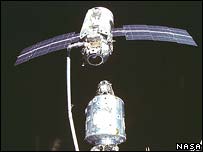 |
Zarya (top) and Unity – the first two ISS modules
|
A 19,300-kg (42,250-lb), 12.6-m (41 ft) long, 4.1-m (13 ft) wide module, equipped with solar arrays and six nickel-cadmium batteries capable of generating an average of 3 kW of power, that provided early propulsion, power, fuel storage, and communication, and served as the rendezvous and docking port for Zvezda.
Zarya’s construction was funded by NASA and undertaken in Moscow by Boeing and the Khrunichev State Research and Production Space Center. Following its launch, it was put through a series of tests before being commanded to fire its two large engines to climb to a circular orbit 386 km high. The module's engines and 36 steering jets had a six-ton reservoir of propellant to enable altitude and orientation changes. Its side docking ports are used by Russia’s Soyuz piloted spacecraft and Progress remotely-controlled supply vehicles. As assembly progressed, Zarya's roles were assumed by other Station elements and it is now used primarily as a passageway, docking port and fuel storage site.
Unity Node 1
The first American pressurized module of the ISS. Built at Marshall Space Flight Center, Unity provides six attachment ports, one on each of its sides, to which all future American modules will join. With two mating adaptors attached, it has a mass of 11,500 kg, a length of 10 m, and a diameter of 4.6 m.
Zvezda Service Module
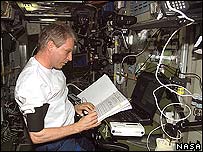 |
ESA astronaut Thomas Reiter performs cardiovascular and cognitive studies in Zvezda
|
The first fully Russian contribution to the ISS and the early cornerstone for human habitation of the station. The 19-ton, 13.1-m-long Zvezda, provided the first living quarters aboard the station, together with electrical power distribution, data processing, flight control, and propulsion systems. It also has a communications system enabling remote command from ground controllers. Although many of its systems will eventually be supplemented or superceded by American components, Zvezda will remain the structural and functional center of the Russian segment of the ISS.
Integrated Truss Structure
An American-supplied framework that serves as the backbone of the ISS and the mounting platform for most of the station’s solar arrays. The truss also supports a mobile transporter that can be positioned for robotic assembly and maintenance operations and is the site of the Canadian Mobile Servicing System, a 16.8-m-long robot arm with 125-ton payload capability and mobile transporter which can be positioned along the truss for robotic assembly and maintenance operations.
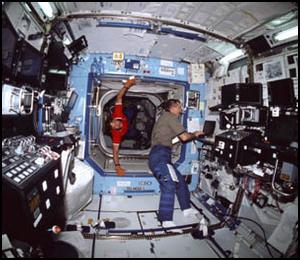 |
Inside the Destiny lab
|
Destiny Laboratory
America’s main workstation for carrying out experiments aboard the ISS. The 16.7-m-long, 4.3-m-wide, 14.5-ton Destiny will support research in life sciences, microgravity, Earth resources, and space science. It consists of three cylindrical sections and two end-cones. Each end-cone contains a hatch through which crew members will enter and exit the lab. There are 24 racks inside the module, 13 dedicated to various experiments, including theGravitational Biology Facility, and 11 used to supply power, cool water, and provide environmental control.
Multi-Purpose Logistics Modules
Effectively the ISS's moving van. Built by the Italian Space Agency it allows the Space Shuttle to ferry experiments, supplies, and cargo back and forth during missions to the station.
Prelude to ISS: the Shuttle-Mir program
Between 1995 and 1998, nine Space Shuttle-Mir docking missions were flown and American astronauts stayed aboard Mir for lengthy periods. Nine Russian cosmonauts rode on the Shuttle and seven American astronauts spent a total of 32 months aboard Mir, with 28 months of continuous occupancy starting in March 1996. By contrast, it took the Shuttle fleet more than a dozen years and 60 flights to accumulate one year in orbit. Valuable experience was gained in training international crews, running an international space program, and meeting the challenges of long-duration spaceflight for mixed-nation astronauts and ground controllers. Dealing with the real-time challenges of the Shuttle-Mir missions also fostered in a new level of cooperation and trust between those working on the American and Russian space programs.
The ISS takes shape
Construction of the ISS began in late 1998 and was originally projected to involve a total of 45 assembly missions, including 36 by the Shuttle, and numerous re-supply missions by unmanned Progress craft and rotations of Soyuz crew-return vehicles.
| Early ISS missions |
|---|
| Launch date | Description |
| Nov. 20, 1998 | A Proton rocket places the Zarya module in orbit |
| Dec. 4, 1998 | Shuttle mission STS-88 attaches the Unity module to Zarya |
| May 27, 1999 | STS-96 delivers tools and cranes to the two modules |
| May 19, 2000 | STS-101 conducts maintenance and delivers supplies in preparation for arrival of Zvezda and the station’s first permanent crew |
| Jul. 12, 2000 | A Proton rocket delivers Zvezda |
| Sep. 8, 2000 | STS-106 delivers supplies and outfits Zvezda |
| Oct. 11, 2000 | STS-92 delivers the Z1 Truss, a pressurized mating adapter for Unity, and four gyros |
| Nov. 2000 | Arrival of Expedition One crew aboard a Soyuz spacecraft |
| Nov. 30, 2000 | STS-97 installs the first set of American solar arrays |
| Feb. 7, 2001 | STS-98 delivers the Destiny laboratory module and relocates a pressurized mating adapter from the end of Unity to the end of Destiny |
| Mar. 8, 2001 | STS-102 brings Expedition Two crew plus equipment for Destiny and returns with Expedition One crew |
| Apr. 19, 2001 | STS-100 delivers Remote Manipulator System and more laboratory equipment |
| Jul. 12, 2001 | STS-104 delivers the station’s joint airlock |
| Aug. 2001 | Arrival of the Expedition Three crew and return of Expedition Two |
| Sep. 2001 | Delivery of the Russian docking compartment by a Soyuz rocket
|
| ISS crews |
|---|
| Expedition | Docking to undocking period | Commander | Flight engineers |
| One | Nov. 2, 2000–Mar. 18, 2001 | William Shepherd | Yuri Gidzenko, Sergei Krikalev |
| Two | Mar. 10, 2001–Aug. 20, 2001 | Yuri Usachev | Susan Helms, Jim Voss |
| Three | Aug. 12, 2001–Dec. 15, 2001 | Frank Culbertson
| Vladimir Dezhurov, Mikhail Tyurin |
| Four | Dec. 5, 2001–Jun. 15, 2002 | Yury Onufrienko
| Dan Bursch, Carl Walz |
| Five | Jun. 7, 2002–Dec. 2, 2002 | Valery Korzun
| Sergei Treschev, Peggy Whitson |
| Six | Nov. 25, 2002–May 3, 2003 | Ken Bowersox
| Nikolai Budarin, Don Petitt |
| Seven | Apr. 28, 2003–Oct. 23, 2003 | Yuri Malenchenko
| Ed Lu |
| Eight | Oct. 20, 2003–Apr. 29, 2004 | Michael Foale
| Alexander Kaleri |
| Nine | Apr. 24, 2004–Oct. 23, 2004 | Gennady Padalka
| Mike Fincke |
| Ten | Oct. 15, 2004–Apr. 24, 2005 | Leroy Chiao
| Salizhan Sharipov |
| Eleven | Apr. 16, 2005–Oct. 10, 2005 | Sergei Krikalev
| John Phillips |
| Twelve | Oct. 3, 2005–March 2006 | William McArthur
| Valery Tokarev |
| Thirteen | Mar. 31, 2006–Sep. 28, 2006 | Pavel Vinogradov
| Thomas Reiter, Jeffrey Williams |
| Fourteen | Sep. 20, 2006–Apr. 21, 2007 | Michael Lopez-Alegria
| Sunita Williams, Mikhail Tyurin |
| Fifteen | Apr. 9, 2007–Oct. 21, 2007 | Fyodor Yurchikhin
| Clayton Anderson, Oleg Kotov |
| Sixteen | Oct. 12, 2007–Apr. 19, 2008 | Peggy A. Whitson
| Yuri Malenchenko, Daniel M. Tani |
| Seventeen | Apr. 10, 2008–Oct. 23, 2008 | Sergei Volkov
| Oleg Kononenko, Garrett E. Reisman, Gregory E. Chamitoff |
| Eighteen | Oct. 14, 2008– | Michael Fincke
| Sandra Magnus, Koichi Wakata |







0 comments:
Post a Comment